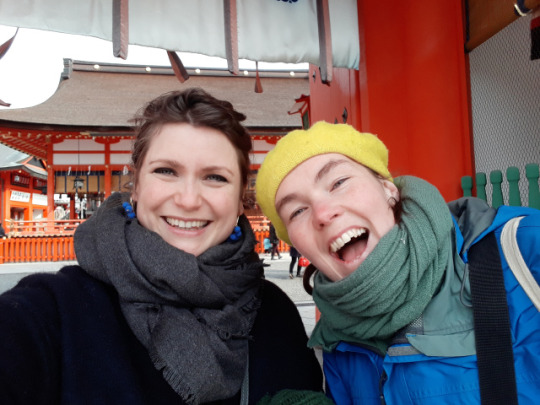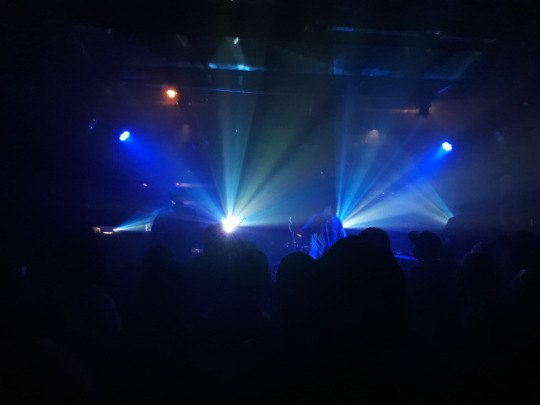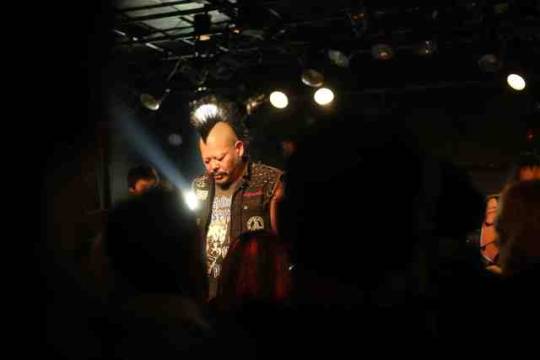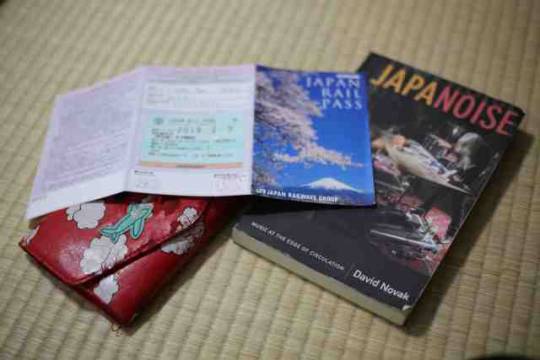Don't wanna be here? Send us removal request.
Text
Inclusive Music/Noise-making in Japan, by Geraldine Heaney
Inclusive Music/Noise-making in Japan, by Geraldine Heaney
Inclusive Music/Noise Making in Japan
In January 2019, Scottish artists Geraldine Heaney and Ellie Griffiths travelled to Japan to explore inclusive music approaches. Geraldine co-runs KOR! Records, that create experimental music projects for young people with additional support needs and releases their output. Ellie makes sensory performances for and with young people with complex needs, in…
View On WordPress
0 notes
Text
In January 2019, Scottish artists Geraldine Heaney and Ellie Griffiths travelled to Japan to explore inclusive music approaches. Geraldine co-runs KOR! Records, that create music projects for young people with additional support needs and releases their output. Ellie makes sensory performances for and with young people with complex needs, in which live music is a key component. The trip was funded by Creative Scotland and supported by Independent Arts Projects.

Ellie and Geraldine
This research aimed to open up new, accessible ways of making and experiencing live music. Both artists were keen to embrace non-normative music cultures and practices that have the potential to widen out who is at the centre of the work. Although working in different ways, both artists are passionate about the power of music to create spaces where people can be listened to and express themselves authentically.
Japan is the a global centre for experimental and noise music, making it an ideal setting for this research. Referred to broadly as ‘Japanoise’, there’s a rich history of music here that has developed an expansive tonal palette to include abrasive textures, feedback, object noises, field recordings and even silence. Artists working in this way such as Boredoms, C.C.C.C. and Hijokaidan have gained huge cult success in the last few decades and strong international followings.
Here the artists talk about their time in Japan…
EG: On this trip, I wanted to open my ears. Since being a teenager I have had fairly set music taste that is largely restricted to rootsy, acoustic music. I’m slightly sound sensitive so tend to seek out low intensity listening experiences. In my work with young people who have profound autism, I have noticed a strong interest in object noises and have made the connection before between this and the work of Japanese artists such as Rie Nakajima. I notice many young people I work with seek really high intensity sound experiences. One parent told me how her son likes to go home after school, shut the curtains, take his clothes off, turn the lights out and listen to thrash metal music full blast. In terms of access, this is never what is imagined when making work for autistic audiences. This makes me keen to expand my musical horizons so I can make work that is engaging for a wider variety of people and preferences.
GH: We visited a range of venues: Small scale live houses with incredible lighting rigs, longstanding venues, repurposed Japanese houses, tiny cafes and the 100-year-old Guggenheim House that has become an established music venue, community hub and home. We attended a range of gigs: Noise, Punk, Experimental Improvisation, Melodic composition, Classical guitar and live music for children. We heard stories of: connections to Scotland, community projects, plans for adventure, ideas for establishing community, traditional tales, musical explorations, cultural differences and human histories. There’s so much to process and so many experiences that I know will take a lot longer to understand the full impact on my work and my thinking.
EG: A highlight for me was going to a noise gig by Endon, and also seeing experimental musician PHEW at Superdeluxe (the venue Café Oto in London was inspired by). Both are performances I wouldn’t have usually chosen to go to, but I found both utterly compelling. The vibration through the floor, the beat that feels stronger than your heartbeat at times, the mesmeric quality of having your whole body absorbed in sound. These were the sort of gigs you would never get my audiences at, and yet they were so sensory! I liked how having the focus of listening made us more sensitive to sounds that appeared in our everyday experiences. Japan is a noisy place in many parts. It was a great way to absorb this new culture, and fed into our thinking about active listening.

GH: Improvisation was a theme in our trip. We saw a lot of brilliant improvised music. This can be a naturally inclusive approach without the structures or rules of more classical or prescribed forms of music. (more about this and meeting the inclusive improvisation collective Otoasobi Project in the next blog). We also improvised our journey around Japan. We took risks on things we didn’t know much about, took advice from locals and made changes to our plans to respond to what was happening. We missed trains and had to find new directions to go in. There’s a lot more to think about in terms or sound, noise, listening, inclusion, disability and connection.



You can hear and see some short sound highlights of the trip here.
Sensory Listening in Japan In January 2019, Scottish artists Geraldine Heaney and Ellie Griffiths travelled to Japan to explore inclusive music approaches.
0 notes
Text
Does Spoken Language Stop Us From (really) Listening?
Does Spoken Language Stop Us From (really) Listening?
This January, Geraldine Heaney and I were delighted to be invited to take part in the Theatre for Young Audiences Inclusive Arts Festival in Tokyo Japan. A big part of this was presenting our film ‘Frame’ which we made as part of an Imaginate artist residency, in collaboration with pupils from St Crispin’s School.
The film questions who has the right to make art? which the festival created…
View On WordPress
0 notes
Text
Playful Tiger Tour: Guest blog by Jade Adamson
Playful Tiger Tour: Guest blog by Jade Adamson
Playful Tiger, which has been made with and for for young audiences who are profoundly autistic and mainly non-verbal, is proving to be both one of the most exciting shows I have been involved in as a performer and one of the most challenging. It’s exciting because as much as the show’s structure is set and there are strict choreographic rules, we have permission and are encouraged to deviate and…
View On WordPress
0 notes
Text
SINNERLIGT: Making a Sensory Exhibition
SINNERLIGT: Making a Sensory Exhibition
SINNERLIGT is a commission by Scen:se, a brilliant multi-disciplinary project created by Eva Von Hofsten to bring sensory art and performance to Sweden. Making work for neurodiverse audiences is one of the only areas of inclusivity that Sweden are actually a bit behind the UK on. Visual artist Laura Blakeand I are collaborating to make an inclusive sensory exhibition, which will tour galleries in…
View On WordPress
0 notes
Text
Playful Tiger: Venue Training and Sensory Audits. Guest blog by Coery Nicholson
Playful Tiger: Venue Training and Sensory Audits. Guest blog by Coery Nicholson

Hello, my name’s Coery and I’m a performer. Some of you might have seen me as the Guardian of the Labyrinth recently in ‘The Reason I Jump’ which was a show by the National Theatre of Scotland. This show was based on a book by a Japanese author Naoki Higashida, who is non-verbal and on the autistic spectrum. (I read the book with my mum, it’s good, especially for learning about autism, I’d…
View On WordPress
0 notes
Text
Playful Tiger, Guest blog 2: Dancer Jade Adamson
Playful Tiger, Guest blog 2: Dancer Jade Adamson

Dance Artist, Jade Adamson, gives insight into the last week of Playful Tiger by Barrowland Ballet, in collaboration with Ellie Griffiths, research and development.
For the last part of our research and development for Playful Tiger, we focused on exploring ways of interaction through physical contact and vocalisation as well as trying out more of the performative sections of the show. Through…
View On WordPress
0 notes
Text
Playful Tiger: Guest Blog by Dancer Kai-Wen Chuang
Playful Tiger: Guest Blog by Dancer Kai-Wen Chuang
Roar- It’s the Playful Tiger We’ve had an exciting and interesting week back in the studio, with research and development into our new production Playful Tiger. Dance Artist Kai-Wen Chuang shares her thoughts on the process so far.
Playful Tiger is a new Barrowland Ballet production inspired by the successful children dance theatre performance Tiger Tale. It is a version of the show being made…
View On WordPress
0 notes
Text
The Reason I Jump: Creative Process
The Reason I Jump: Creative Process
The National Theatre of Scotland recently staged a version of The Reason I Jump, by Naoki Higashida. Naoki has profound autism and learned to communicate primarily using an alphabet grid and began to write poems and short stories. At the age of thirteen he wrote The Reason I Jump, has now been published in more than thirty languages. The book describes Naoki’s lived experience of having autism,…
View On WordPress
0 notes
Text
FRAMES, Blog 5: The Film
FRAMES, Blog 5: The Film

“Creativity needs trust to flourish. Learn each other’s worlds. Build the art in a way that demonstrates you know their world” Anne Basting
The final experiment of the FRAMES residency was to make a film in collaboration with film maker Geraldine Heaney, and the pupils of St Crispin’s School. We wanted to make something which took the pupils seriously as makers of art. Our central…
View On WordPress
0 notes
Text
FRAMES, Blog 4: The Art of Disruption
FRAMES, Blog 4: The Art of Disruption


For the second part of the FRAMES residency I wanted to go bolder, include more of the pupils and have more visual impact on the school environment. This was inspired by my trip to Milwaukee (as part of my Churchill Fellowship) to spend time with the incredible Anne Basting of Timeslips.
This company works collaboratively with older people and those living with dementia. Hearing Anne speak…
View On WordPress
0 notes
Text
FRAMES, Blog 3: Accepting Limitations (or not)
FRAMES, Blog 3: Accepting Limitations (or not)

The viewfinder experiment I did in the last FRAMES session went broadly as I hoped, but left me with an uncomfortable feeling that lingered with me all week. It was clear that those individuals who are visual-seekers enjoyed this form. However, for those who are taste, touch or smell-driven, it was not fully satisfying.
The pyramid of development (triangles keep making an appearance!), shows…
View On WordPress
0 notes
Text
FRAMES, Blog 2: Ways of Watching
FRAMES, Blog 2: Ways of Watching
“I had always known that the world was fragmented. My mother was a smell and a texture, my father was a tone and my older brother was something which was moving about.”
This is a quote by author Donna Williams, who is on the autistic spectrum. She wrote an autobiography ‘Nobody Nowhere’, among other books about autism.

blog 2 attemptblog 2 attemptA sense of the fragmented perception…
View On WordPress
0 notes
Text
FRAMES, Blog 1: Getting started
FRAMES, Blog 1: Getting started
This week I was delighted to start a pilot artist residency with Imaginate, embedding me for the term in St Crispin’s school, which is for pupils who have severe needs (mainly non-verbal) on the autistic spectrum.
Having visited a couple of times before, I was really excited by the idea of being based there. The pupils in St Crispin’s are aged 4-19, but developmentally (as the school define it)…
View On WordPress
0 notes
Text
*All photos by Laurence Thorn, featuring DIY participants: Joan Somers Donnelly, Nicola Smith, Naomi O’Kelly, Rachel Clerke, Vicki Browne, Greg Sinclair and Ellie Griffiths, alongside the staff and pupils from Sherbourne Fields School.
What it was all about
The Live Art Development Agency’s DIYs are unusual professional development projects conceived and run by and for artists. LADA DIY: Neuroaesthetics was a four-day workshop focused on creating performance with and for neurodiverse children.
As one part of my practice, I work as a theatre and movement workshop facilitator in training centres for adults with intellectual disabilities. I’m based in Dublin, and would love to see more space in Ireland for both adults and children with complex needs to engage in performance-making. I was motivated to apply by both that desire, and the fact that the project combined working with neurodiverse people and creating experimental performance, as naturally compatible rather than mutually exclusive fields.
What we did
We were working between two locations in Coventry: the Herbert Gallery and Museum, and Sherbourne Fields School, a local special school for pupils between the ages of 2 and 19. On our first day we were based in the gallery. Ellie Griffiths and Greg Sinclair, who were leading the DIY, described their practices and experiences in the world of performance and neurodiversity. We also watched videos of the work of other artists, had discussions, and did some partnered sensory exercises and solo performance-making. By the end of Day One my brain was tired but buzzing with information and ideas. I think the whole group felt stimulated but a little nervous in anticipation of our trip to the school the following day.
The next day we met at Sherbourne Fields School, where we spent the morning in different classes, observing some of the eight children we would be working with. Most were between the ages of 8 and 11, were on the autism spectrum and were nonverbal, and many had other additional needs.
For the first 40 minute session that afternoon we divided the group in half, so that three of us would work with the pupils for 20 minutes, and then the other 2 of us would work with them for the second 20 minutes. I was in the first group, and we had planned a loose performance inviting participation, involving moving lights and object behind a plastic sheet. As soon as the children had entered and been brought to sit in front of the sheet, we realised a problem with this set-up: we couldn’t see the children’s reactions through it. We moved, to interact with the children on their side of the sheet, using props. The children seemed to move between momentary interest in the objects we presented to them, and disinterest or distress. I felt at a loss for ideas, and a bit useless.
We only had a short time between the first group of children leaving the room and the second group arriving to assess what we wanted to differently this time. We all felt a level of dissatisfaction and even failure in our first attempt. Two people decided that just watching the next session was a better way for them to learn. The other three of us wanted to engage with the children, but differently. We played the whole thing by ear, trying to be present with the children and presenting actions and objects spontaneously. This made for a very different, and enjoyable rather than stressful, experience. It felt like non-pressured play, and in a couple of moments it also felt like an interesting group improvisation, with people in different parts of the room “vibing” off each other. After the afternoon sessions we went back to the Herbert to reflect on the day. A lot of doubts were expressed, but also the beginnings of ideas and ‘lines of enquiry.’
The next day we were back in the school. Our challenge for the day was to think about how to bring our own practice into these experiments. What were the core interests or aims of our practice, and how might we bring those into the play with the children? This seemed like a tricky question, but it proved useful to think about. It was also fascinating to hear and see how that question played out for the other artists that day, as it gave us insights into the different possible manifestations of this work. I returned to a concept that Ellie had mentioned on the first day: some people, neurodiverse or otherwise, are smell-seekers, some are sight-seekers, some are touch-seekers, and so on, and you will see that reflected in behaviour or patterns of interests. I am definitely a movement-seeker, in life and in my practice, so I decided to focus on investigating different ways to play with movement one-on-one, and to test out what movement the children might like to watch as well.
Our sessions with the children that afternoon were very different to the day before. We began with offerings of performance, materials, and an interesting visual environment, and each session evolved into a stimulating and aesthetically intriguing mess of movement, sounds, visuals, partnerships and sellotape, which I think everyone enjoyed being part of at some stage.




The gallery visit
Our final day was spent in the gallery. Our task was to create a performance/environment/participatory installation, for the pupils, who were coming to the Herbert that afternoon. We each planned different areas or events that would overlap or connect within an overall structure. It was very hard to know what to expect once the children arrived into it!
Ellie and Greg greeted the pupils and accompanying teachers and support workers and explained that the children could move and interact freely with us and the materials and installation.

It began tentatively. Our nervousness of the first day in the school seemed to return, thanks to an implied pressure to ‘perform,’ in both senses of the word. Slowly though, the children started to interact with the space, with the materials, and with us.
There were moments of calm and moments of chaos, moments of watching and movements of doing, moments of quiet and moments of collective sound-making/singing. There were moments of joyful destruction and moments of reconstruction, moments of playful physical contact and moments of running away, moments of movement and moments of stillness, and moments of collaboration too.
I followed the impulses I would in an improvisation, sometimes working alone, sometimes building something with another person or persons, allowing things happening near or far from me to influence my decisions too. Yes, there were things that made it more challenging than some improvisations, for example sometimes potential collaborators simply weren’t interested in what I was doing, but I felt that that also made me cycle through bad ideas more quickly, to get to the things we were both genuinely interested in.

Many of these children perceive the world very differently to those of us who identify as neurotypical. Many naturally explore their sensory environment and respond to those stimuli creatively, by moving, touching, shouting, singing, building etc. I can only guess what their motivations for those actions might be, but I think I can relate to the impulse. Observing and playing with some of those children made me want to push my physical exploration of my own curiosities much further than I have been doing lately. It also reminded me of the cool places you can go in a collaboration that wouldn’t be possible alone.

Brain stuff, and thank yous
A lot of big questions bubbled up for all of us during the four days. When does play become improvisation? When, if ever, does work with young people labelled as being neurodiverse become collaborative? How can you tell? Is there an audience for this work? Where does this fit into the contemporary performance world, or does it even need to? Do the children have an awareness of the ‘art’ framing of what we are doing together? If they don’t, is there a problem with us presenting it as art?
Interestingly, in the latter two days I was questioning the basis of my critical questions of the first two days. So instead of asking where the consent of the children to partake in art-making was in the work, I was asking myself why I was assuming that none of the pupils were aware of the framing of what we were doing as art or performance, even if they didn’t have a name for it, and also how clear that boundary really is, between play and improvisation and creation.





This DIY was invigorating. It was a pleasure to meet and work with such incredible people, big and small. It allowed me to follow some previous lines of thinking into reality for the first time, and introduced me to new ideas and approaches around perception and performance-making.
Many many thanks to all the staff at the Herbert and Sherbourne Fields who made us feel so welcome, to LADA for making the opportunity possible, to the inspiring other artists, to the incredible kids, and to our fabulous workshop leaders and organisers, Ellie and Greg.
Written by Joan Somers-Donnelly
*Huge thanks to Joan for her brilliant contribution to this project and for writing the blog.
‘Learning to Make a Mess’, LADA DIY 14: Neuroaesthetics *All photos by Laurence Thorn, featuring DIY participants: Joan Somers Donnelly, Nicola Smith, Naomi O'Kelly, Rachel Clerke, Vicki Browne, Greg Sinclair and Ellie Griffiths, alongside the staff and pupils from Sherbourne Fields School.
0 notes
Text
‘Spinning Bowls and Milk Bottle Shoes’: Thoughts on ‘Sound Symphony’ Research and Development process
‘Spinning Bowls and Milk Bottle Shoes’: Thoughts on ‘Sound Symphony’ Research and Development process
Written by Ellie Griffiths, Lead artist of Upfront ‘Sound Symphony’ is a new piece of contemporary performance by Upfront, made for and with young audiences on the autistic spectrum. Through Creative Scotland’s Open Project Fund, we were able to start putting our ideas into action: It was a hugely exciting couple of weeks, packed full of discoveries, surprises and questions often leading to more…
View On WordPress
0 notes
Text
I Miss Japan
In Autumn 2016, Tim and Amanda Webb of Oily Cart had the exciting opportunity to travel to Japan, sharing their practice and collaborating with local artists, educators and practitioners to explore possibilities of making work for young audiences with complex disabilities. Here Tim writes about their fond memories of their trip… ‘Amanda Webb, designer for Oily Cart, UK young people’s theatre…
View On WordPress
0 notes